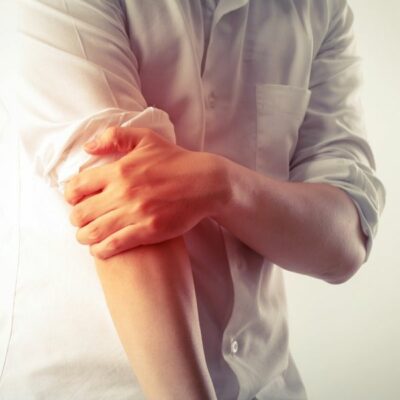Elbow Osteochondritis Dissecans (OCD) Specialist

Are you a young athlete who participates in throwing sports, such as pitching baseball? The forceful and repeated actions of this sport and others can strain the immature surface of the outer part of the elbow joint. These athletes may be prone to an odd and troubling elbow condition called osteochondritis dissecans of the elbow or (OCD.) Elbow OCD specialist, Dr. James Mazzara provides diagnosis and both surgical and nonsurgical treatment options for patients in Manchester, South Windsor, Enfield, Glastonbury and surrounding Hartford communities who have developed osteochondritis dissecans of the elbow. Contact Dr. Mazzara’s team today!
What is osteochondritis dissecans of the elbow?
Young baseball pitchers, gymnasts, racket-sport players and overhand athletes are prone to an odd and troubling elbow condition called osteochondritis dissecans of the elbow or (OCD.) The forceful and repeated actions of these sports can strain the immature surface of the outer part of the elbow joint. It involves a loss of blood supply (or death) to part of the cartilage and underlying bone within the elbow joint. Without adequate blood flow, a small section of bone dies, cracks and may break off. Dr. James Mazzara, orthopedic elbow specialist serving Manchester, South Windsor, Enfield, Glastonbury and surrounding Hartford communities has extensive experience in treating patients with osteochondritis dissecans of the elbow.
Most often found in young athletes, between the ages of 12-20, osteochondritis dissecans of the elbow used to be called “Little Leaguer’s Elbow.” This nick-name was given because it was so often seen in young baseball pitchers. Now, however, OCD has been found in athletes who participate in other sports such as gymnastics or racket-sports.
What causes OCD of the elbow in adolescents?
The cause of osteochondritis dissecans of the elbow is unknown however it is believed that genetics may play a role. OCD of the elbow often occurs among relatives and is sometimes seen through several generations in the same family. Other possible causes:
- Repetitive throwing motions can create an overload or stress injury to the elbow.
- Overuse of the elbow joint due to repetitive overhead and upper extremity weight bearing activities such as gymnastics and throwing can cause microfractures.
- History of significant trauma.
What are the symptoms of osteochondritis dissecans of the elbow?
- Pain aggravated by motion
- Stiffness, especially after resting
- Elbow instability
- Popping or clicking in the joint (called crepitus)
- Tenderness when moving the elbow
- Elbow locking or difficulty moving the joint
Severe cases of elbow OCD that are not treated early tend to create bigger problems as the patient ages. There is a high potential for long term disability, with many patients being unable to return to the same level of sport activity and up to 50% of patients developing arthritis long term. The joint may become arthritic early in adulthood, causing loss of use of the elbow.
How is elbow OCD diagnosed?
Dr. Mazzara will conduct a thorough medical history as well as physical examination of the patient’s elbow. He will check for tenderness, range of motion, pain and crepitus when the elbow is bent or straightened. X-rays are needed to confirm the diagnosis and often an MRI will help determine the amount of damage to surrounding soft tissues and bone damage. Lesions or tears found through an MRI are classified as follows:
- Grade 1: Stable – Cartilage is intact but there is thickening and beginning signal changes within the bone. (A signal change means the MRI has found an abnormality.)
- Grade 2: Stable – Cartilage has been damaged and there is a lesion (crack or tear) in the bone.
- Grade 3: Unstable – Cartilage has been damaged and there is a bone fragment with synovial fluid present.
- Grade 4: Unstable – Loose body (such as a piece of bone) within the joint.
How is “Little League Elbow” treated?
Athletes will need to stop their usual sporting activity that led to elbow OCD. Dr. Mazzara may prescribe a non-steroidal anti-inflammatory medicine to help reduce pain and swelling within the joint. Eventually physical therapy may be necessary to help with flexibility and range of motion. Therapists also work with athletes to help them improve their form in ways that reduce strain on the elbow during sports. In severe cases, patients may wear a sling or splint to immobilize the joint and facilitate healing. In younger patients, less than 10 years old, this condition is usually called Panner’s disease and will usually heal over time.
How to treat elbow OCD with surgery
The type and extent of surgical treatment depends on the grade of the lesion. Dr. Mazzara can perform this type of surgery either openly (where he opens the elbow to see the joint clearly) or arthroscopically with small incisions and small surgical instruments. He may perform one or more of the following procedures:
- Debridement: This is common for elbow OCD and involves clearing away the damaged tissue with a small shaving instrument. Often, Dr. Mazzara will use a small instrument to poke holes through the damaged area and into the healthy bone just below. This causes the holes to bleed and promotes healing.
- Pinning: If the section of bone has detached, Dr. Mazzara may pin the bone back in place with bio-absorbable pins.
- Grafting: A small area of damaged bone in the joint may be replaced with a graft. An autograft is tissue from the patient’s own body, taken from a nearby area and placed in the damaged area. Smaller lesions can be grafted with the patient’s own bone and cartilage in an OATS procedure. Larger lesions may require donor grafting procedures.
For more information on osteochondritis dissecans of the elbow, or if your teen is suffering from elbow pain, please contact the orthopedic office of Dr. James Mazzara, elbow specialist, serving patients living in Manchester, South Windsor, Enfield, Glastonbury and surrounding Hartford Connecticut communities.
